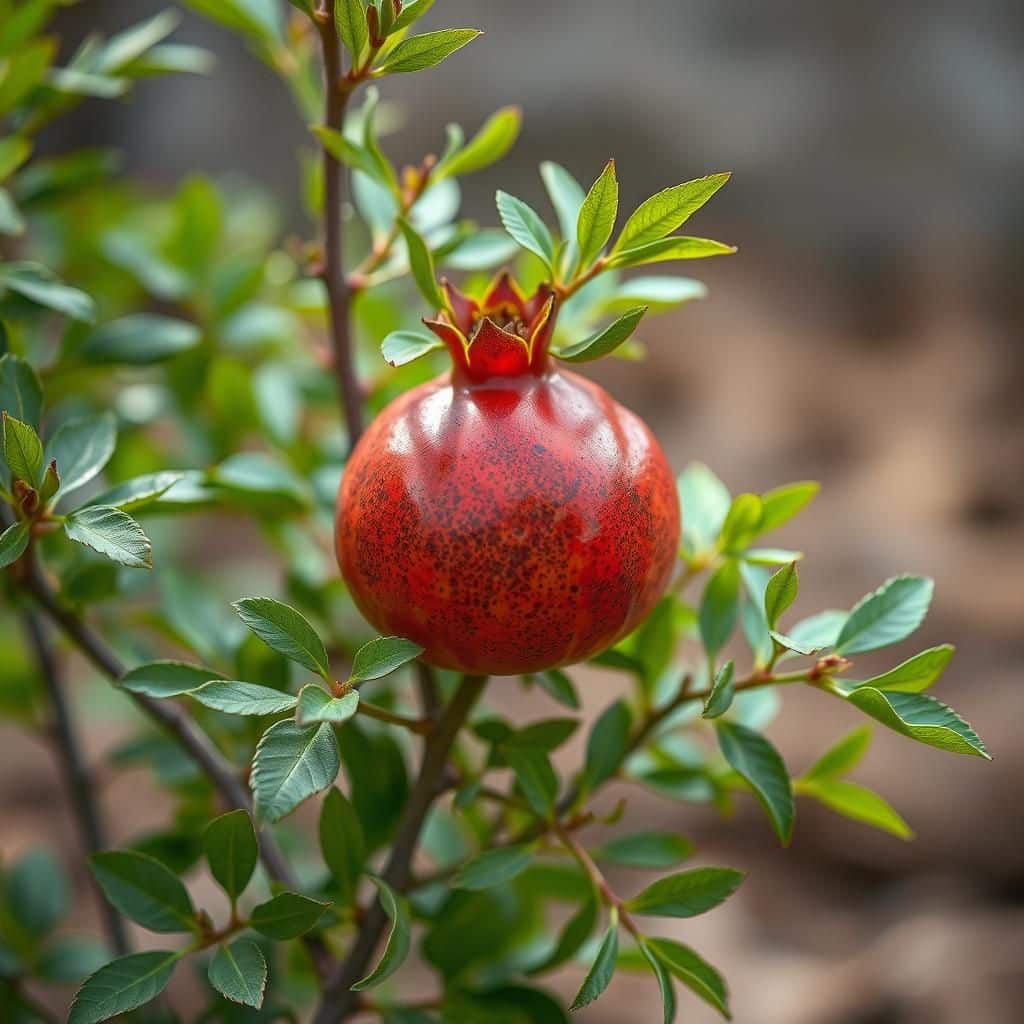Ultimate Guide on How to Grow a Pomegranate Plant: Tips for Thriving Growth

Growing a pomegranate plant can be a rewarding endeavor, offering not only picturesque beauty but also delicious fruit. This ultimate guide will equip you with essential tips and insights to ensure your pomegranate thrives in any environment. Whether you’re a seasoned gardener or a novice, understanding the right conditions for growth, proper watering techniques, and pest management strategies is crucial. With the right knowledge and care, your pomegranate plant can flourish, providing you with bountiful harvests for years to come. Dive in as we explore the key elements to successfully grow and maintain your pomegranate plant!
How to Successfully Grow a Pomegranate Plant
Growing a pomegranate plant requires a suitable environment and specific care to ensure healthy growth and abundant fruit production. Start by selecting the right variety, as some are better suited for certain climates. Pomegranates thrive in warm, sunny locations with well-draining soil, and they prefer a pH level between 5.5 and 7.0. Watering should be moderate; over-watering can lead to root rot, while under-watering can stress the plant. Regular pruning is also important to encourage a strong structure and better fruit yield. Fertilizing with balanced nutrients during the growing season will support vigorous growth and flower production.
Choosing the Right Variety
When it comes to pomegranates, several varieties exist, each with unique characteristics. Dwarf varieties are ideal for smaller gardens or container planting, while larger varieties produce more fruit and require more space. The Wonderful variety is the most common in commercial production, known for its sweet and juicy seeds. Researching and selecting a variety that suits your climate and landscape will greatly enhance your success with growing pomegranates.
Optimal Growing Conditions
Pomegranate plants flourish in warm climates, typically thriving in United States Department of Agriculture (USDA) zones 7 to 10. They prefer full sunlight, meaning at least six hours of direct sunlight each day. Additionally, ensure the soil is well-draining to prevent water accumulation, which can lead to root rot. Placing the plant in a location sheltered from strong winds can also help to protect the blossoms from damage.
Watering Techniques
Proper watering is vital for the health of your pomegranate plant. Water deeply, ensuring moisture reaches the root zone, but avoid keeping the soil consistently soggy. It's important to allow the top inch of soil to dry out between waterings, which encourages deeper root growth. During the flowering and fruiting stages, increase the frequency of watering, especially in dry spells, while always being cautious not to over-water.
Pruning for Better Yield
Pruning helps maintain the shape and promotes better air circulation within the pomegranate plant. During late winter or early spring, before new growth begins, remove any dead, damaged, or crossing branches. Focus on creating an open center that allows light to penetrate, which is crucial for fruit development. Regular pruning encourages a more productive plant, resulting in a healthier crop and easier maintenance.
Fertilizing Your Pomegranate Plant
To promote vigorous growth, applying balanced fertilizers during the growing season is essential. Start with a slow-release fertilizer in early spring, following the manufacturer's instructions for application rates. This will provide essential nutrients that support flowering and fruit-setting. Additionally, organic options like compost or well-rotted manure can enrich the soil, enhancing its fertility naturally over time.
| Factor | Optimal Condition |
|---|---|
| Climate | USDA zones 7 to 10 |
| Sunlight | 6+ hours of direct sunlight |
| Soil pH | 5.5 to 7.0 |
| Watering Frequency | Drought-tolerant; water deeply but infrequently |
| Fertilization | Balanced fertilizer in spring; compost for enrichment |
How to grow a pomegranate at home?


To grow a pomegranate at home, you need to follow a series of steps to ensure that the plant thrives. Pomegranates can be cultivated both in the ground and in containers, making them suitable for various gardening setups. Here’s a detailed approach:
Choosing the Right Variety
Selecting the appropriate pomegranate variety is crucial to ensure successful growth. Different varieties may have specific climate preferences or fruit characteristics.
- Provence: Known for its sweet and juicy fruits, this variety thrives in hot climates.
- Angel Red: This type is favored for its heavy production and disease resistance.
- Wonderful: A popular choice, known for its large, juicy seeds and vibrant color.
Preparing the Soil
The soil plays a vital role in the growth of a pomegranate tree. It should be well-draining and rich in nutrients to ensure the roots develop healthily.
- pH Level: Ensure the soil pH is between 5.5 and 7 for optimal growth.
- Organic Matter: Incorporate compost or well-rotted manure to enhance nutrient content.
- Drainage: If planting in heavy soil, consider raised beds or adding sand to improve drainage.
Planting the Pomegranate
When planting a pomegranate, timing and method are essential to ensure robust growth. This usually occurs in the spring or fall, depending on your climate.
- Seed or Cuttings: You can start from seeds, but using cuttings results in a faster-growing tree.
- Spacing: If planting multiple trees, space them about 10-15 feet apart to allow for adequate growth.
- Watering: Water the plant thoroughly after planting, and maintain consistent moisture during the early growth stage.
Watering and Fertilization
Proper water management is essential for the health of the pomegranate tree. The frequency and method of watering can affect fruit development significantly.
- Frequency: Water the tree deeply but infrequently, allowing the topsoil to dry out between waterings.
- Fertilizer: Apply a balanced fertilizer during the growing season to promote fruiting and flowering.
- Mulching: Consider adding mulch around the base to retain soil moisture and control weeds.
Pest and Disease Management
Maintaining a healthy pomegranate plant also involves monitoring for pests and diseases that can affect growth and yield.
- Common Pests: Watch for aphids, fruit flies, and whiteflies, which can harm the plant.
- Diseases: Fungal infections like leaf spot can occur; ensure good air circulation and avoid overhead watering.
- Natural Remedies: Use insecticidal soap or neem oil as a natural pest management strategy, if necessary.
Can you grow pomegranates in the US?

Yes, you can grow pomegranates in the U.S. They thrive in regions with a warm climate and well-drained soil. The U.S. Department of Agriculture (USDA) provides a hardiness zone map that helps in determining the best areas for growing pomegranates. Primarily, California, Texas, and parts of the Southwest offer ideal conditions for cultivation due to their hot summers and mild winters. With proper care, pomegranates can yield rewarding harvests, making them an attractive choice for both home gardeners and commercial growers.
See also:
Growing Zones for Pomegranates
Regions like California, Arizona, and southern Texas are among the best for growing pomegranates. They generally fall within USDA hardiness zones 7 to 10. Here are some key points:
- California: Most favorable conditions for pomegranate cultivation.
- Arizona: Hot climates benefit the growth cycle of pomegranates.
- Texas: Southern regions are suitable, whereas northern areas may experience colder winters.
Soil Requirements
Pomegranates require well-drained soils, as they are susceptible to root rot if the soil retains too much moisture. The following soil characteristics are important:
- pH Level: Ideal range is between 5.5 and 7.0.
- Drainage: Sandy loam or loamy soil is preferred.
- Nutrients: Enriched soils with organic matter can improve growth.
Watering Needs
While pomegranates are drought-tolerant, they do require adequate hydration during their growing season. Essential watering tips include:
- Deep Watering: Encourage root growth by watering deeply but less frequently.
- Avoid Overwatering: Excess moisture can damage the roots.
- Mulching: Helps retain soil moisture and regulate temperature.
Pests and Diseases
Like all crops, pomegranates can be affected by pests and diseases. Key considerations include:
- Pests: Watch for aphids, pomegranate butterflies, and mealybugs.
- Diseases: Fungal infections can arise in overly wet conditions.
- Management: Implement integrated pest management (IPM) strategies and organic pesticides.
Harvesting Pomegranates
Harvesting is a crucial aspect of growing pomegranates, with timing critical for ensuring flavor and quality. Attention to these details will ensure a successful harvest:
- Ripeness: Look for a vibrant color and a metallic sounding fruit when tapped.
- Timing: Typically ready to harvest in the fall, between September and November.
- Storage: Store harvested fruits in a cool, dry place to extend shelf life.
Questions from Our Readers
What type of soil is best for growing a pomegranate plant?
To ensure healthy growth, pomegranate plants thrive in well-drained soils with a pH level between 5.5 and 7.0. It's essential to use light, sandy loam or sandy soil to prevent waterlogging, which can harm the plant's roots.
How much sunlight does a pomegranate plant need?
Pomegranate plants require at least 6 to 8 hours of direct sunlight per day for optimal growth and fruit production. Insufficient sunlight can lead to stunted growth and fewer blooms, affecting the overall yield of the plant.
When is the best time to plant a pomegranate tree?
The ideal time to plant a pomegranate tree is in spring after the last frost or in fall in milder climates. Planting during these times allows the tree to establish its roots before the more extreme heat of summer or the cold of winter.
See also:
How often should I water my pomegranate plant?
Pomegranate plants prefer deep watering rather than frequent shallow watering. During the growing season, it's best to water them every 1 to 2 weeks, allowing the top few inches of soil to dry out between waterings to avoid overwatering.
https://youtube.com/watch?v=qS3OmcknAZw
If you want to read more articles like Ultimate Guide on How to Grow a Pomegranate Plant: Tips for Thriving Growth, we recommend you check out our Seeds category.
Leave a Reply
Related Articles